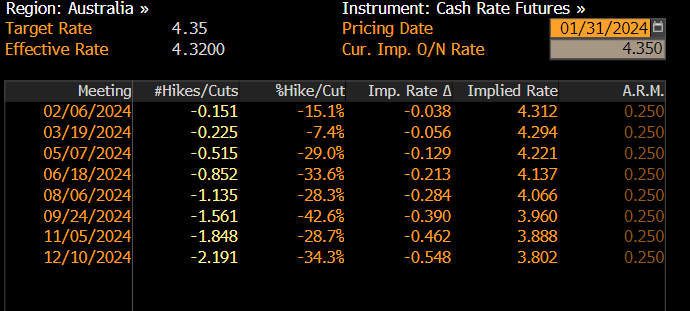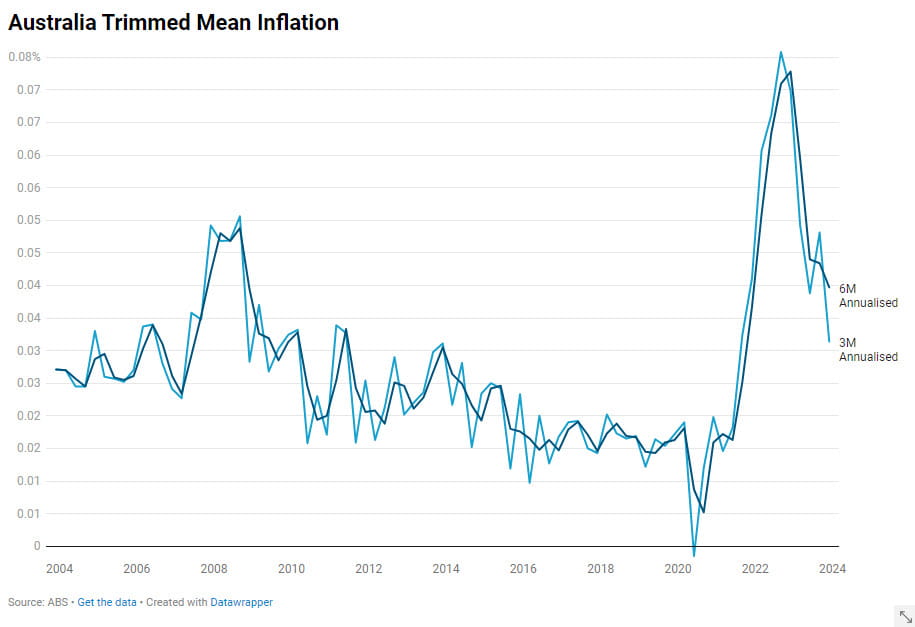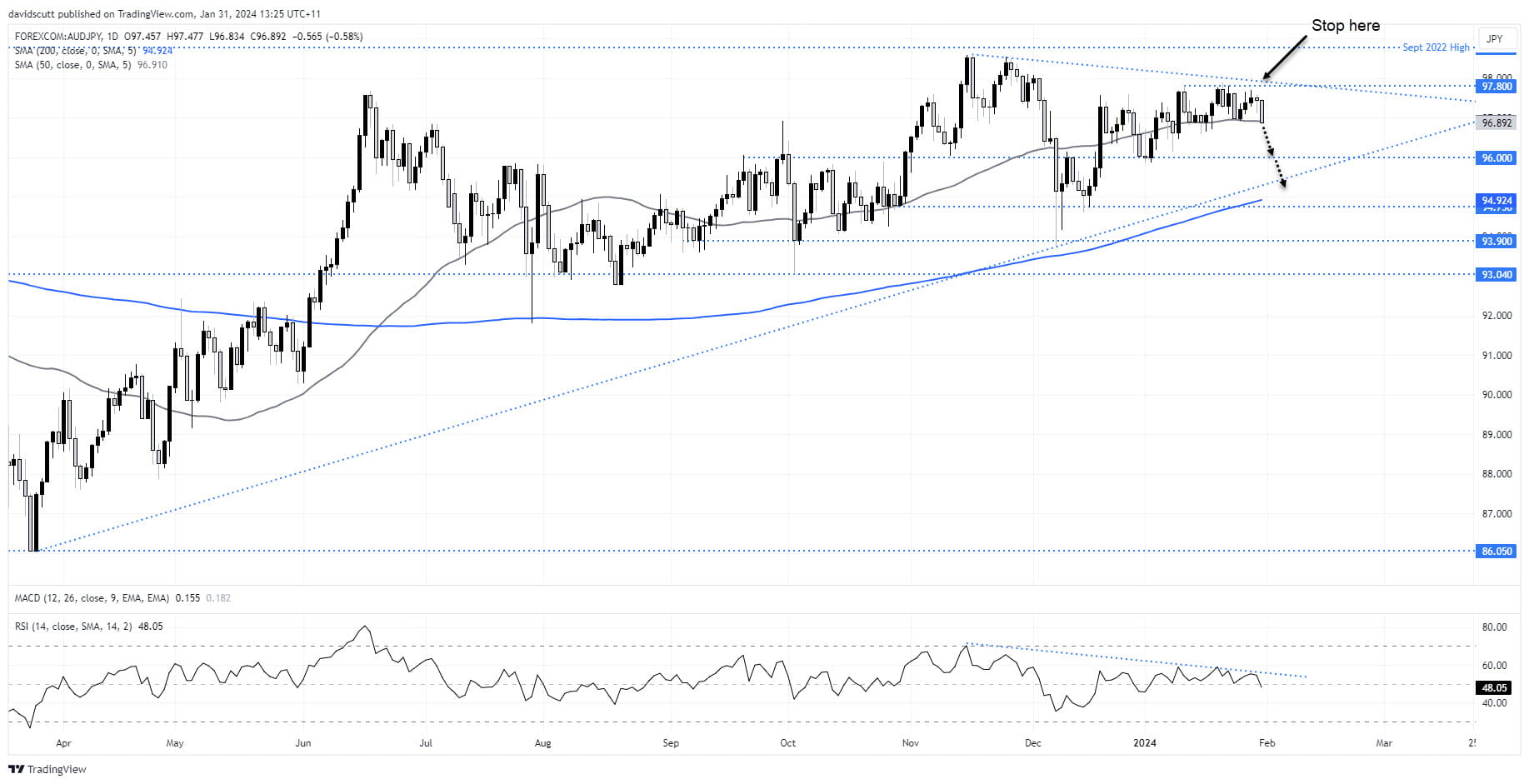
- Australia’s December quarter consumer price inflation report came in under market and RBA forecasts
- Despite inflation remaining well above the RBA’s 2.5% midpoint target, recent data suggests consumer spending and labour market conditions are weakening
- Markets marginally favour a rate cut from the RBA by May
- Australian households are heavily indebted with most mortgage rates set off the overnight cash rate, making shifts in monetary policy more efficient than most other nations.
There’s a growing risk the Reserve Bank of Australia (RBA) may end up cutting interest rates sooner than US Federal Reserve with a slowdown in underlying inflationary pressures in the December quarter, on top of signs of stalling consumer spending and softening labour market conditions, seeing markets shift forward expectation for a 25 basis point rate cut to early May.
RBA rate cut brought forward to May
You can see in this screenshot from Bloomberg that implied rate cut pricing based off cash rate futures is now seen at just over 50% for May with more than two full cuts now priced into the curve by the end of the calendar year.

Source: Bloomberg, X
Australian inflation still too high but cooling fast
The catalyst for the shift in pricing came from the release of Australia’s Q4 consumer price inflation (CPI) report which showed both headline and underlying price pressures undershooting economist and RBA forecasts.
Headline CPI rose 0.6% for the quarter and 4.1% over the year, the slowest pace seen the June quarter of 2021. Trimmed mean inflation, the RBA’s preferred measure of underlying pressures, grew by 0.8% for the quarter and 4.2% from a year earlier. Markets were looking for a quarterly increase of 0.8% with an annual rate of 4.4%. Importantly, the quarterly figure was two-tenths below the RBA’s November forecast, and three tenths over the year.
On a nearer-term basis, trimmed mean inflation on a three-month annualised basis now sits at 3.16%, just above the top of the RBA’s 2-3% target. The six-month annualsied rate sits closer to 4%, although both are clearly moderating from the elevated levels seen in 2022 and 2023.

Economic indicators are rolling over
While no one is disputing that inflation remains too high, given recent weakness in other Australian economic indicators, there’s a growing risk that prior RBA rate hikes – including in November last year – may be starting to clamp down hard on broader activity levels. On Tuesday, it was reported that retail sales tumbled 2.7% from a month earlier. There was also a sizeable drop in employment reported over the same month, led by full time workers. While seasonality quirks meant there was plenty of statistical noise in both, the underlying message from both was activity is slowing down. Potentially fast.
When you think about Australia's mortgage market structure, and the level of household debt we carry relative to other developed nations, there was always a risk RBA tightening would bite harder on activity than in other parts of the world. We're loaded up to the gills with mortgage debt with mortgage rates set off the front of the borrowing curve. Contrast that to a place like the United States where most mortgage rates have been locked in at ultra-low levels for decades, making rate hikes from the Fed far less efficient on crimping activity than those delivered by the RBA.
Following the latest data, make sure you put February 6 in the calendar. The RBA’s first monetary policy decision of 2024 could well see the bank join others in signaling an eventual policy pivot.
AUD off, bonds and ASX pop
Markets have responded exactly how you would expect to the inflation undershoot with the Australian dollar coming under pressure against a basket of major currencies. Three and 10-year bond futures are also rallying following the bid in the front of the curve with yields down 10 and eight basis points respectively. Australia’s ASX 200 came within a whisker of hitting record highs.
Matt Simpson has several trade recommendations on those markets here and here.
AUD/JPY maybe an option for AUD bears
For mine, when it comes to the Aussie dollar cross where there’s potential for a significant market move given the tricky geopolitical environment and shifting domestic interest rate outlook, it’s hard to look past AUD/JPY.
Having contemplated taking out the highs set in late 2022 and in late 2023 earlier this month, the pair has run into sellers constantly at 97.80 despite the risk positive environment. Following Australia’s latest inflation report, it’s now testing the 50-day moving average around 96.90. While not a major level, a clean break could easily usher in a move towards support at 96.04. Below that, uptrend support and 200-day moving average will provide a stern test for shorts, should AUD/JPY get there.
Those interested in a short trade could initiate a position targeting uptrend support/200DMA with a stop-loss order above 97.80 for protection. Should AUD/JPY move lower, the stop could be lowered to the original entry point.

-- Written by David Scutt
Follow David on Twitter @scutty
How to trade with City Index
You can trade with City Index by following these four easy steps:
-
Open an account, or log in if you’re already a customer
• Open an account in the UK
• Open an account in Australia
• Open an account in Singapore
- Search for the market you want to trade in our award-winning platform
- Choose your position and size, and your stop and limit levels
- Place the trade











